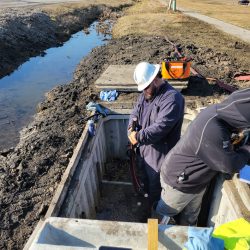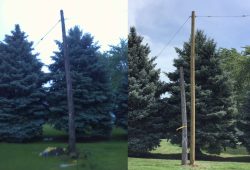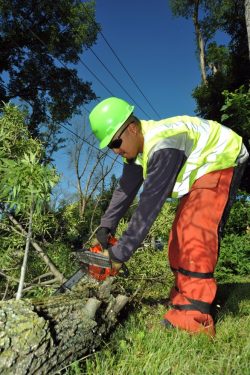
This summer is expected to bring abnormally high temperatures and inclement weather, with more than 840 tornadoes already touched down in the U.S. this year. As summer months heat up, this brings a higher likelihood of storms, as well as additional energy demand stemming from the surge in air conditioners use in order to keep our homes and buildings cool.
In addition to year-round efforts to deliver nation-leading reliability for our customers across northern Illinois, additional steps are taken ahead of the summer months to prepare our distribution equipment spread across more than 11,000 square miles to withstand heat, storms, and more.
“ComEd is prepared to handle the heat,” said Rommel Noguera, director of project and contract management for ComEd. “Because we know the summer brings its own unique challenges to the power grid, we prepare well in advance to accommodate all weather factors that come with the season. Completing critical work before the summer ensures power reliability for all our communities when they need it most.”
Here are three ways ComEd shores up the system for some of the grid’s most challenging months.

ComEd line worker splicing underground cable.
Summer Preparedness Program
With kids back home from school in the hot summer months, ACs are practically running 24/7 all across ComEd’s footprint, adding tremendous load to grid equipment, especially in urban areas. ComEd teams begin working immediately following each summer season to identify areas that require equipment upgrades or improved electricity flow to ensure systems run smoothly for at least the next two summers. Construction to deliver 90 system upgrades happened well before the first day of summer.
During the spring, customers might have seen crews extending power lines, working inside a substation, or updating poles and wires. At the end of the summer season, assessments are performed to prepare the system for the following year, continuing the cycle of the summer preparedness program.

Before and after pole replacement.
Electric Wood Pole Program
Severe storms, which surge in frequency in the summer months, hit above-ground power equipment the hardest, including wooden poles. ComEd regularly inspects and treats its wood distribution poles in a 10-year cycle. To properly assess over 1 million poles across ComEd’s service territory, anywhere between 120,000 and 150,000 poles are inspected each year. When a wooden pole no longer meets ComEd standards for remaining strength, it is evaluated for reinforcement and/or pole replacement to prevent failures and proactively strengthen our electrical distribution grid.
Vegetation Management

Extreme summer heat also brings severe storms with strong winds which can break and knock trees and limbs onto power lines and other equipment, and cause service interruptions. To prepare for this, a specialized team of contracted tree trimmers and arborists work to minimize the risk before severe weather arrives.
The ComEd Vegetation Management team helps avoid storm-related outages and supports power restoration by pinpointing locations that have experienced multiple interruptions and have had nearby canopies assessed for risk.
Certified arborists are engaged to identify species of trees and types of branches known to affect power, providing specialized instruction on how to treat leafy usual suspects in infamous pocket areas where they grow.
Every day, over 600 ComEd contractors work to proactively trim trees and branches that may come into contact with power equipment, resulting in vegetation trimmed along 8,000 miles of distribution lines and along over 1,000 miles of transmission lines each year.
These efforts contributed to ComEd seeing record-breaking reliability in 2023, including a reduction in the frequency of outages.
As climate change continues to intensify weather conditions, both in summer and during seasons all year round, ComEd is hardening the grid through a series of improvement projects, including transferring overhead power equipment to underground where possible – all to maintain strong reliability for 9 million people served in the region. Customers can also prepare themselves each year for the summer by keeping an eye out for overgrown trees and branches and lowering their energy use by adopting energy-efficient habits and technology, like heat pumps. To request tree removal or trimming near power equipment, submit a service request here. To learn more about how to lower your energy usage and bill learn more here.
